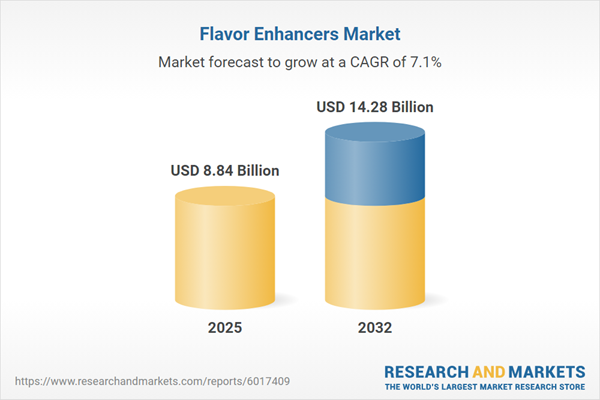Speak directly to the analyst to clarify any post sales queries you may have.
Senior leaders seeking a competitive edge in food innovation will find actionable insights in this comprehensive flavor enhancers market report. Covering the engines of growth, strategic responses to evolving consumer and regulatory landscapes, and supply chain adaptation, this analysis guides agile decision-making for sustainable growth.
Market Snapshot: Flavor Enhancers Market Overview
The flavor enhancers market grew from USD 8.27 billion in 2024 to USD 8.84 billion in 2025, and is projected to expand at a CAGR of 7.06%, reaching USD 14.28 billion by 2032. Expanding applications across bakery, dairy, and beverage categories are driven by manufacturers’ quest for improved taste, clean-label reformulation, and enhanced consumer experience. Regulatory momentum and investments in advanced ingredient technologies continue to shape a diverse, innovation-focused market.
Scope & Segmentation
- Applications: Bakery & Confectionery (including breads, cakes, pastries, chocolates), Beverages (juices, soft drinks), Dairy & Frozen Products (cheese, ice cream, yogurt), Processed Meats (bacon, ham, sausage), Savory Products (dressings, sauces, seasonings), Snacks (chips, popcorn, pretzels), Soups & Broths (instant, ready-to-serve).
- Forms: Flake, Liquid, Paste, Powder.
- Types: Disodium 5'-Ribonucleotides, Monosodium Glutamate, Protein Hydrolysates, Yeast Extracts.
- Sources: Natural (with animal-based and plant-based categories), Synthetic.
- Regions: Americas (United States, Canada, Mexico, Brazil, Argentina, Chile, Colombia, Peru), Europe, Middle East & Africa (United Kingdom, Germany, France, Russia, Italy, Spain, Netherlands, Sweden, Poland, Switzerland, United Arab Emirates, Saudi Arabia, Qatar, Turkey, Israel, South Africa, Nigeria, Egypt, Kenya), Asia-Pacific (China, India, Japan, Australia, South Korea, Indonesia, Thailand, Malaysia, Singapore, Taiwan).
- Key Companies: Ajinomoto Co., Inc., International Flavors & Fragrances, Inc., Givaudan S.A., Symrise AG, Kerry Group plc, Sensient Technologies Corporation, BASF SE, Ingredion Incorporated, Tate & Lyle PLC, Corbion N.V.
Key Takeaways: Strategic Insights for Decision-Makers
- Clean-label and health-driven reformulations are accelerating, making naturally derived ingredients central to new product pipelines and regulatory compliance.
- Technological innovations—such as analytical tools and biotech-based fermentation—are enabling the precise tailoring of flavor profiles and supporting clean-label objectives.
- Sourcing diversification and local production help fortify supply chains against policy volatility, especially in response to shifting regulatory landscapes and tariff disruptions.
- Partnerships between global conglomerates, niche extract suppliers, and biotech innovators drive rapid product development and align portfolios with changing consumer preferences.
- Enhanced transparency, through blockchain and traceability solutions, strengthens brand trust and aligns with retailer requirements for authenticity and sustainability.
Tariff Impact: 2025 Tariffs Reshape Supply Strategies
The imposition of US tariffs in 2025 has led to upstream cost pressures across synthetic flavor enhancer supply. Market participants have adapted by recalibrating sourcing strategies, prioritizing local alternatives, and increasing investment in natural extraction technologies. These changes prompted mergers and acquisitions among mid-sized suppliers and spurred dual-sourcing approaches among end-users to mitigate risk and ensure price stability.
SEO Focus: Flavor Enhancers Market Dynamics
The flavor enhancers market is shaped by evolving consumer demand for authentic, memorable food experiences and increasing expectations for transparency. As innovation cycles shorten and ingredient technologies multiply, manufacturers must align application-specific, form-driven, and source-based selections to address cultural preferences and regulatory boundaries on a global scale. Across all regions, localized R&D and strategic partnerships are pivotal in rapidly adapting to emerging taste and wellness trends.
Methodology & Data Sources
This report is founded on primary interviews with leading flavor chemists, executives, and regulatory experts, bolstered by secondary research from peer-reviewed literature and industry whitepapers. Data triangulation and robust scenario analysis ensure findings are comprehensive and reliable for senior decision-makers. Sensitivity checks were performed to reflect regulatory and supply chain diversity across regions.
Why This Report Matters
- Enables leaders to anticipate disruptive trends and strategically reconfigure sourcing, formulation, and innovation models in a dynamic global market.
- Delivers application-specific, regionally relevant insights to support investment decisions and portfolio adjustments for sustained differentiation.
- Equips stakeholders with practical guidance to enhance resilience, compliance, and consumer alignment through proactive supply chain and product strategies.
Conclusion
The future of taste optimization lies in strategic flexibility, rapid innovation, and integrated supply networks. This report equips senior leaders with clear, actionable insights for navigating the flavor enhancer landscape and unlocking sustainable growth opportunities worldwide.
Additional Product Information:
- Purchase of this report includes 1 year online access with quarterly updates.
- This report can be updated on request. Please contact our Customer Experience team using the Ask a Question widget on our website.
Table of Contents
3. Executive Summary
4. Market Overview
7. Cumulative Impact of Artificial Intelligence 2025
Companies Mentioned
The companies profiled in this Flavor Enhancers market report include:- Ajinomoto Co., Inc.
- International Flavors & Fragrances, Inc.
- Givaudan S.A.
- Symrise AG
- Kerry Group plc
- Sensient Technologies Corporation
- BASF SE
- Ingredion Incorporated
- Tate & Lyle PLC
- Corbion N.V.
Table Information
| Report Attribute | Details |
|---|---|
| No. of Pages | 193 |
| Published | November 2025 |
| Forecast Period | 2025 - 2032 |
| Estimated Market Value ( USD | $ 8.84 Billion |
| Forecasted Market Value ( USD | $ 14.28 Billion |
| Compound Annual Growth Rate | 7.0% |
| Regions Covered | Global |
| No. of Companies Mentioned | 11 |









